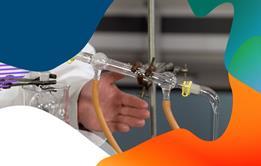Learn how to use redox chemistry in titrations as well as qualitative tests to determine the relative oxidising ability of the halogens and reactivity series of metals
Redox chemistry describes reactions in which one component is oxidised (loses electrons) and another component is reduced (gains electrons).
There are two well-known, classroom-based redox titrations:
1. Determining the concentration of Fe2+ ions in solution
The underlying chemistry of the redox reaction is shown below.
5Fe2+(aq) + MnO4-(aq) + 8H+(aq) → 5Fe3+(aq) + Mn2+(aq) + 4H2O(l)
For many students, balancing the equation will be the first challenge followed by the multistep calculations to determine the concentration of the Fe2+ ions. Mistakes are likely to be made when considering the 5:1 ratio of Fe(II) ions to the manganate ion. It’s also important to draw students’ attention to the part that adding sulfuric acid (H+ ions) plays in the overall redox reaction.
2. Determining the concentration of sodium thiosulfate solution
The underlying chemistry of the redox reaction is shown below and takes place in two parts. A redox reaction takes place in the conical flask prior to the titration.
10I-(aq) + 2MnO4-(aq) + 16H+(aq) → 5I2(aq) + 2Mn2+(aq) + 8H2O(l)
A second redox reaction takes place on addition of sodium thiosulfate…
I2(aq) + 2S2O32-(aq) → S4O62-(aq) + 2I-(aq)
…although it’s more accurate to identify that it is likely a triiodide ion is oxidising the sulfur in the thiosulfate ion to the tetrathionate ion.
I-(aq) + I2(aq) → I3-(aq)
I3-(aq) + 2S2O32-(aq) → S4O62-(aq) + 3I-(aq)
The starch indicator is only added near the endpoint of the titration as the starch-triiodide complex can stabilise over time in a high concentration of I2 and becomes difficult to reduce.
Questions you could ask your students for both redox reactions:
- Which species is being reduced?
- Which species is being oxidised?
- Why don’t we directly titrate iodine solution with sodium thiosulfate?
- Why is no indicator used in the iron tablet titration?
- Why is starch used as an endpoint indicator in the thiosulfate titration?
- What is the oxidation number of manganese in the permanganate ion?
- What is the oxidation number of sulfur in the thiosulfate ion and in the tetrathionate ion?
For more videos on redox titrations, please see Practical videos: titrations.
The following video from Pdst chemistry provides detailed demonstrations of the halogens as oxidising reagents, as well as metal displacement reactions:
- Chlorine with bromide ions
- Chlorine with iodide ions (1:33)
- Bromine with iodide ions (2:13)
- Halogen reactions with sulfite ions (3:58)
- Halogen reactions with Fe2+ ions (6:52)
- Displacement reactions of Zn with Cu2+. (8:39)
- Displacement reaction of Mg with Cu2+ (9:52)
In all of these experiments, invite your students to write balanced redox equations. Ensure they grasp what is meant by the terms ‘oxidise’ and ‘reduce’ and which species is acting as the oxidising/reducing agent. For example, here are two different ways to describe the reaction of chlorine with bromide ions:
- Chlorine oxidises the bromide ions to bromine.
- The bromide ion reduces the chlorine to chloride ions.
Finally, ask your students what they would expect to happen if they added bromine to a solution containing chloride ions. Why?
Also check out
- Teaching redox chemistry post-16 offers ideas, exercises and experiments to help your students get on top of this challenging topic
- Get fresh ideas and tips in 4 ways to teach redox in terms of electrons.
- Use our Redox starters for 10 questions, great as a diagnostic tool or plenary at the end of a session.
Additional information
We have collated these videos of key practical experiments to support remote teaching as part of our response to Covid-19. Teachers requested resources to help them deliver practical content without access to laboratories or equipment. We are developing further resources and welcome feedback to help us produce those you most need. Please email us or use the comment section below.
Practical videos | 16–18 years

Videos of key practical techniques and apparatus for revision, flipped learning or remote teaching
- 1
- 2
- 3
- 4
- 5
- 6
- 7
- 8
- 9
- 10
- 11
- 12
 Currently
reading
Currently
reading
Redox











































2 readers' comments